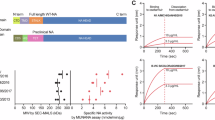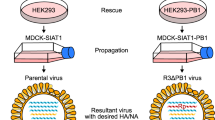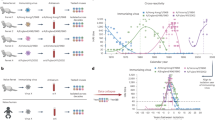Abstract
Infection with influenza virus induces antibodies to the viral surface glycoproteins hemagglutinin and neuraminidase, and these responses can be broadly protective. To assess the breadth and magnitude of antibody responses, we sequentially infected mice, guinea pigs and ferrets with divergent H1N1 or H3N2 subtypes of influenza virus. We measured antibody responses by ELISA of an extensive panel of recombinant glycoproteins representing the viral diversity in nature. Guinea pigs developed high titers of broadly cross-reactive antibodies; mice and ferrets exhibited narrower humoral responses. Then, we compared antibody responses after infection of humans with influenza virus H1N1 or H3N2 and found markedly broad responses and cogent evidence for 'original antigenic sin'. This work will inform the design of universal vaccines against influenza virus and can guide pandemic-preparedness efforts directed against emerging influenza viruses.
This is a preview of subscription content, access via your institution
Access options
Access Nature and 54 other Nature Portfolio journals
Get Nature+, our best-value online-access subscription
27,99 € / 30 days
cancel any time
Subscribe to this journal
Receive 12 print issues and online access
209,00 € per year
only 17,42 € per issue
Buy this article
- Purchase on SpringerLink
- Instant access to full article PDF
Prices may be subject to local taxes which are calculated during checkout






Similar content being viewed by others
References
Jayasundara, K., Soobiah, C., Thommes, E., Tricco, A.C. & Chit, A. Natural attack rate of influenza in unvaccinated children and adults: a meta-regression analysis. BMC Infect. Dis. 14, 670 (2014).
Krammer, F. & Palese, P. Advances in the development of influenza virus vaccines. Nat. Rev. Drug Discov. 14, 167–182 (2015).
Horimoto, T. & Kawaoka, Y. Influenza: lessons from past pandemics, warnings from current incidents. Nat. Rev. Microbiol. 3, 591–600 (2005).
Wrammert, J. et al. Broadly cross-reactive antibodies dominate the human B cell response against 2009 pandemic H1N1 influenza virus infection. J. Exp. Med. 208, 181–193 (2011).
Pica, N. et al. Hemagglutinin stalk antibodies elicited by the 2009 pandemic influenza virus as a mechanism for the extinction of seasonal H1N1 viruses. Proc. Natl. Acad. Sci. USA 109, 2573–2578 (2012).
Margine, I. et al. H3N2 influenza virus infection induces broadly reactive hemagglutinin stalk antibodies in humans and mice. J. Virol. 87, 4728–4737 (2013).
Yu, X. et al. Neutralizing antibodies derived from the B cells of 1918 influenza pandemic survivors. Nature 455, 532–536 (2008).
Ohmit, S.E., Petrie, J.G., Cross, R.T., Johnson, E. & Monto, A.S. Influenza hemagglutination-inhibition antibody titer as a correlate of vaccine-induced protection. J. Infect. Dis. 204, 1879–1885 (2011).
Heaton, N.S., Sachs, D., Chen, C.J., Hai, R. & Palese, P. Genome-wide mutagenesis of influenza virus reveals unique plasticity of the hemagglutinin and NS1 proteins. Proc. Natl. Acad. Sci. USA 110, 20248–20253 (2013).
Yewdell, J.W., Webster, R.G. & Gerhard, W.U. Antigenic variation in three distinct determinants of an influenza type A haemagglutinin molecule. Nature 279, 246–248 (1979).
Wohlbold, T.J. & Krammer, F. In the shadow of hemagglutinin: a growing interest in influenza viral neuraminidase and its role as a vaccine antigen. Viruses 6, 2465–2494 (2014).
Yang, X. et al. A beneficiary role for neuraminidase in influenza virus penetration through the respiratory mucus. PLoS One 9, e110026 (2014).
Wohlbold, T.J. et al. Vaccination with adjuvanted recombinant neuraminidase induces broad heterologous, but not heterosubtypic, cross-protection against influenza virus infection in mice. MBio 6, e02556 (2015).
Easterbrook, J.D. et al. Protection against a lethal H5N1 influenza challenge by intranasal immunization with virus-like particles containing 2009 pandemic H1N1 neuraminidase in mice. Virology 432, 39–44 (2012).
Ekiert, D.C. et al. Antibody recognition of a highly conserved influenza virus epitope. Science 324, 246–251 (2009).
Ekiert, D.C. et al. A highly conserved neutralizing epitope on group 2 influenza A viruses. Science 333, 843–850 (2011).
Sui, J. et al. Structural and functional bases for broad-spectrum neutralization of avian and human influenza A viruses. Nat. Struct. Mol. Biol. 16, 265–273 (2009).
Dreyfus, C. et al. Highly conserved protective epitopes on influenza B viruses. Science 337, 1343–1348 (2012).
Jegaskanda, S., Weinfurter, J.T., Friedrich, T.C. & Kent, S.J. Antibody-dependent cellular cytotoxicity is associated with control of pandemic H1N1 influenza virus infection of macaques. J. Virol. 87, 5512–5522 (2013).
Jegaskanda, S. et al. Cross-reactive influenza-specific antibody-dependent cellular cytotoxicity antibodies in the absence of neutralizing antibodies. J. Immunol. 190, 1837–1848 (2013).
Laidlaw, B.J. et al. Cooperativity between CD8+ T cells, non-neutralizing antibodies, and alveolar macrophages is important for heterosubtypic influenza virus immunity. PLoS Pathog. 9, e1003207 (2013).
DiLillo, D.J., Palese, P., Wilson, P.C. & Ravetch, J.V. Broadly neutralizing anti-influenza antibodies require Fc receptor engagement for in vivo protection. J. Clin. Invest. 126, 605–610 (2016).
Terajima, M. et al. Complement-dependent lysis of influenza a virus-infected cells by broadly cross-reactive human monoclonal antibodies. J. Virol. 85, 13463–13467 (2011).
DiLillo, D.J., Tan, G.S., Palese, P. & Ravetch, J.V. Broadly neutralizing hemagglutinin stalk-specific antibodies require FcγR interactions for protection against influenza virus in vivo. Nat. Med. 20, 143–151 (2014).
Nachbagauer, R. et al. Induction of broadly reactive anti-hemagglutinin stalk antibodies by an H5N1 vaccine in humans. J. Virol. 88, 13260–13268 (2014).
Henry Dunand, C.J. et al. Both neutralizing and non-neutralizing human H7N9 influenza vaccine-induced monoclonal antibodies confer protection. Cell Host Microbe 19, 800–813 (2016).
Krause, J.C. et al. Human monoclonal antibodies to pandemic 1957 H2N2 and pandemic 1968 H3N2 influenza viruses. J. Virol. 86, 6334–6340 (2012).
Smith, G.J. et al. Origins and evolutionary genomics of the 2009 swine-origin H1N1 influenza A epidemic. Nature 459, 1122–1125 (2009).
Krammer, F. & Palese, P. Universal influenza virus vaccines: need for clinical trials. Nat. Immunol. 15, 3–5 (2014).
Miller, M.S. et al. Neutralizing antibodies against previously encountered influenza virus strains increase over time: a longitudinal analysis. Sci. Transl. Med. 5, 198ra107 (2013).
Krammer, F. & Palese, P. Influenza virus hemagglutinin stalk-based antibodies and vaccines. Curr. Opin. Virol. 3, 521–530 (2013).
Li, Y. et al. Immune history shapes specificity of pandemic H1N1 influenza antibody responses. J. Exp. Med. 210, 1493–1500 (2013).
Garten, R.J. et al. Antigenic and genetic characteristics of swine-origin 2009 A(H1N1) influenza viruses circulating in humans. Science 325, 197–201 (2009).
Li, G.M. et al. Pandemic H1N1 influenza vaccine induces a recall response in humans that favors broadly cross-reactive memory B cells. Proc. Natl. Acad. Sci. USA 109, 9047–9052 (2012).
Gao, R. et al. Human infection with a novel avian-origin influenza A (H7N9) virus. N. Engl. J. Med. 368, 1888–1897 (2013).
Chen, H. et al. Clinical and epidemiological characteristics of a fatal case of avian influenza A H10N8 virus infection: a descriptive study. Lancet 383, 714–721 (2014).
Martínez-Sobrido, L. & García-Sastre, A. Generation of recombinant influenza virus from plasmid DNA. J. Vis. Exp. 42, 2057 (2010).
Krammer, F. et al. Trichoplusia ni cells (High Five) are highly efficient for the production of influenza A virus-like particles: a comparison of two insect cell lines as production platforms for influenza vaccines. Mol. Biotechnol. 45, 226–234 (2010).
Krammer, F. et al. A carboxy-terminal trimerization ___domain stabilizes conformational epitopes on the stalk ___domain of soluble recombinant hemagglutinin substrates. PLoS One 7, e43603 (2012).
Margine, I., Palese, P. & Krammer, F. Expression of functional recombinant hemagglutinin and neuraminidase proteins from the novel H7N9 influenza virus using the baculovirus expression system. J. Vis. Exp. 81, e51112 (2013).
Xu, X., Zhu, X., Dwek, R.A., Stevens, J. & Wilson, I.A. Structural characterization of the 1918 influenza virus H1N1 neuraminidase. J. Virol. 82, 10493–10501 (2008).
Stevens, J. et al. Structure of the uncleaved human H1 hemagglutinin from the extinct 1918 influenza virus. Science 303, 1866–1870 (2004).
Fonville, J.M. et al. Antibody landscapes after influenza virus infection or vaccination. Science 346, 996–1000. (2014).
Ito, K. et al. Gnarled-trunk evolutionary model of influenza A virus hemagglutinin. PLoS One 6, e25953 (2011).
Borg, I. & Groenen, P. Modern Multidimensional Scaling: Theory and Applications (Springer, 2005).
Acknowledgements
We thank L. Aguado for cloning of several of the HA expression vectors; J. Runstadler (Massachusetts Institute of Technology) for making several avian influenza viruses available to us; F. Amanat for IgG purification; P. E. Leon (Icahn School of Medicine at Mount Sinai) for the H3N8 and H9N4 viruses; C. Marizzi for reviewing the manuscript; BEI Resources for sequences of influenza virus HA and NA; and R. Fouchier (Erasmus MC) for depositing plasmids encoding HA and NA at BEI Resources. Supported by the US National Institutes of Health (U19 AI109946-01 to P.P. and F.K.; and R01 AI117287-01A1 to F.K. and N.M.B.), Centers of Excellence in Influenza Virus Research and Surveillance of the US National Institutes of Health (HHSN272201400008C to A.G.S., P.P., F.K., R.A.M. and N.M.B.), Comisión Nacional de Investigación Científica y Tecnológica (FONDECYT 1121172 and 1161791 to R.A.M.; and PIA ACT 1408 to R.A.M.), and the Chilean Ministry of Economy, Development and Tourism (P09/016-F to R.A.M.).
Author information
Authors and Affiliations
Contributions
R.N., A.C., A.H., I.M. and F.K. performed serological experiments. R.N., A.C., I.M., N.M.B., R.A.A. and F.K. performed animal experiments. A.B., M.F. and R.A.M. acquired clinical samples and performed all necessary experiments to characterize the clinical samples. R.N., S.I., A.G.S., K.I., R.A.M. and F.K. performed data analysis. R.N., R.A.A., P.P., A.G.S. and F.K. contributed to the overall concept, experimental design and hypothesis and wrote the manuscript.
Corresponding author
Ethics declarations
Competing interests
The authors declare no competing financial interests.
Integrated supplementary information
Supplementary Figure 1 Infection strategy.
To test the antibody responses against influenza viruses, animals were sequentially infected with two divergent strains of the same subtype. For H1N1 infections, animals were primed with a human seasonal strain from 1999 (NC99, A/New Caledonia/20/1999), followed by the 2009 human pandemic H1N1 strain (NL09, A/Netherlands/602/2009) six weeks later. These viruses express divergent HA head domains, but similar HA stalk domains. For H3N2 infection animals were primed with a human seasonal strain from 1982 (Phil82, A/Philippines/2/1982), followed by a 2011 human seasonal strain (Vic11, A/Victoria/361/2011). These viruses are separated by almost 30 years of antigenic drift.
Supplementary Figure 2 Viral titers on day 2 after infection in animal models.
Mice (A, n=5/virus), Guinea pigs (B, n=2/virus) and ferrets (C, n=2/virus) were infected with NC99, NL09, Phil82 and Cal09 and viral titers were measured on day 2 post infection from nasal wash (guinea pigs and ferrets) or nasal turbinates (mice).
Supplementary Figure 3 Heat-map presentation of guinea pig antibody titers after infection.
A) Anti-HA titers of guinea pigs (n=3) after one H1N1 (NC99) infection. B) Anti-HA titers of guinea pigs (n=3) after sequential infection with two divergent H1N1 (NC99, NL09) strains. C) Anti-HA titers of guinea pigs (n=3) after one H3N2 (Phil82) infection. D) Anti-HA titers of guinea pigs (n=2) after sequential infection with two divergent H3N2 (Phil82, Vic11) strains. E-H) Anti-NA titers of the corresponding sera to panels A-D.
Supplementary Figure 4 Heat-map presentation of ferret antibody titers after infection.
A) Anti-HA titers of ferrets (n=2) after one H1N1 (NC99) infection. B) Anti-HA titers of ferrets (n=2) after sequential infection with two divergent H1N1 (NC99, NL09) strains. C) Anti-HA titers of ferrets (n=2) after one H3N2 (Phil82) infection. D) Anti-HA titers of ferrets (n=2) after sequential infection with two divergent H3N2 (Phil82, Vic11) strains. E-H) Anti-NA titers of the corresponding sera to panels A-D.
Supplementary Figure 5 Profiles of the titers of cross-reactive antibodies after a single infection in animal models.
Antibody titers measured by ELISA after single influenza virus infection were plotted on the y-axis and the percent amino acid difference to the HA of the strain used for the (later) second infection was plotted on the x-axis. Each point represents the geometric mean titer measured against a single HA (dark blue dot for H1 HAs, light blue dot for other group 1 HAs, dark red triangle for H3 HAs, light red triangle for other group 2 HAs). A non-linear fit (plateau followed by one phase decay) was performed to illustrate the differences in the breadth of the antibody response in all animals. Points for HAs with titers lower than 103 are plotted at 103. A) Mouse group 1 HA titers after H1N1 (NC99) infection. ELISAs were performed on pooled sera of 10 mice and geometric mean titers of technical duplicates are shown. B) Guinea pig group 1 HA titers after H1N1 (NC99) infection. ELISAs were performed on individual sera of 3 guinea pigs and geometric mean titers are shown. C) Ferret group 1 HA titers after H1N1 (NC99) infection. ELISAs were performed on individual sera of 2 ferrets and geometric mean titers are shown. D) Mouse group 2 HA titers after H3N2 (Phil82) infection. ELISAs were performed on pooled sera of 10 mice and geometric mean titers of technical duplicates are shown. E) Guinea pig group 2 HA titers after H3N2 (Phil82) infection. ELISAs were performed on individual sera of 3 guinea pigs and geometric mean titers are shown. F Ferret group 2 HA titers after H3N2 (Phil82) infection. ELISAs were performed on individual sera of 2 ferrets and geometric mean titers are shown.
Supplementary Figure 6 Glycosylation versus antibody titers after infection.
A-C) Antibody titers post 2x infection with either H1N1 (circles) or H3N2 (triangles) against H1 (blue) or H3 (red) HAs were plotted against the number of corresponding glycosylation sites of each HA for all animal models. Mouse samples show the geometric mean of technical duplicates of pooled sera from 10 mice per virus. Guinea pigs show the geometric mean titers of individual animals (H1N1: n=3, H3N2: n=2). For ferrets, the geometric mean titers of individual animals (n=2/virus) is shown. D) Human antibody titers (geometric mean) post pH1N1 (Cal09, n=9) or H3N2 (Vic11, n=10) infection were plotted against the number of glycosylation sites of the corresponding HAs. Circles indicate titers for individuals infected with pH1N1 and triangles indicate titers for individuals infected with H3N2. Symbols for titers measured against H1 HAs are colored red and symbols for titers measured against H3 HAs are colored blue.
Supplementary Figure 7 Profiles of the titers of cross-reactive antibodies after infection of humans with influenza virus.
A) Geometric mean antibody titers of human individuals post pH1N1 infection (n=9) were plotted on the y-axis and the percent amino acid difference to the HA of the infection strain was plotted on the x-axis. Each point represents the geometric mean titer of all individuals measured against a single HA. Dots illustrate group 1 HAs, triangles group 2 HAs and squares influenza B HA. The post-infection titers are shown in color (blue for group 1, red for group 2 and green for influenza B) and the corresponding pre-infection titers are plotted in gray. A non-linear fit (plateau followed by one phase decay) was performed to illustrate the breadth of the antibody response. B) Geometric mean antibody titers of human individuals post H3N2 infection (n=10) were plotted in the same manner as panel A.
Supplementary Figure 8 ELISA of the titers of antibody to HA in humans before and after infection.
A) Heat map representation of pre-pH1N1 infection ELISA antibody titers against HA (geometric mean of 9 individuals). B) Heat map representation of post-pH1N1 infection ELISA antibody titers against HA (geometric mean of 9 individuals). C) Heat map representation of pre-H3N2 infection ELISA antibody titers against HA (geometric mean of 10 individuals). B) Heat map representation of post-H3N2 infection ELISA antibody titers against HA (geometric mean of 10 individuals).
Supplementary Figure 9 Human reactivity to NA before and after infection.
Heat map representations of human geometric mean ELISA antibody titers against NA pre- and post-pH1N1 (A, B, n=9) or H3N2 (C, D, n=10) infections. E-F) Heat map representations of geometric mean fold-induction of antibody titers against NA post H1N1 (E, n=9) or H3N2 (F, n=10) infection in humans. G-H) Geometric mean fold-induction of antibody titers against NA post-pH1N1 (n=9) or post-H3N2 (n=10) infection in humans were sorted by highest induction in a bar graph. Blue bars represent group 1 NAs, red bars group 2 NAs, green influenza B NA and grey the N10 bat isolate. Error bars indicate the 95% confidence intervals.
Supplementary Figure 10 Heat-map presentation of ELISA of titers of human antibodies to HA and NA (geometric mean values), separated by age group.
A) Geometric mean anti-HA titers of 18-20 year olds (n=30). B) Geometric mean anti-NA titers of 18-20 year olds (n=30). C) Geometric mean anti-HA titers of 33-44 year olds (n=30). D) Geometric mean anti-NA titers of 33-44 year olds (n=30). E) Geometric mean anti-HA titers of 49-64 year olds (n=30). F) Geometric mean anti-NA titers of 49-64 year olds (n=30).
Supplementary Figure 11 Serum-transfer experiment.
For each virus challenge, serum samples of 30 individuals per age group were pooled, sterile filtrated and 250 μl of serum intraperitoneally injected into 10 mice for each group. An equal number of mice received immunoglobulin depleted serum as a negative control group. Two hours after the serum transfer, mice were anesthetized and infected with 1 × 105 PFU of virus diluted in PBS (50 μl total volume) intranasally. Five mice each were euthanized on days 3 and 6, their lungs extracted and viral titers measured by plaque assay.
Supplementary information
Supplementary Text and Figures
Supplementary Figures 1–11 and Supplementary Tables 1–4 (PDF 2148 kb)
Rights and permissions
About this article
Cite this article
Nachbagauer, R., Choi, A., Hirsh, A. et al. Defining the antibody cross-reactome directed against the influenza virus surface glycoproteins. Nat Immunol 18, 464–473 (2017). https://doi.org/10.1038/ni.3684
Received:
Accepted:
Published:
Issue Date:
DOI: https://doi.org/10.1038/ni.3684
This article is cited by
-
An intranasally administered IgM protects against antigenically distinct subtypes of influenza A viruses
Nature Communications (2025)
-
SARS-CoV-2-specific plasma cells are not durably established in the bone marrow long-lived compartment after mRNA vaccination
Nature Medicine (2025)
-
Breadth of influenza A antibody cross-reactivity varies by virus isolation interval and subtype
Nature Microbiology (2025)
-
Serological analysis in humans in Malaysian Borneo suggests prior exposure to H5 avian influenza near migratory shorebird habitats
Nature Communications (2024)
-
Bat-borne H9N2 influenza virus evades MxA restriction and exhibits efficient replication and transmission in ferrets
Nature Communications (2024)



